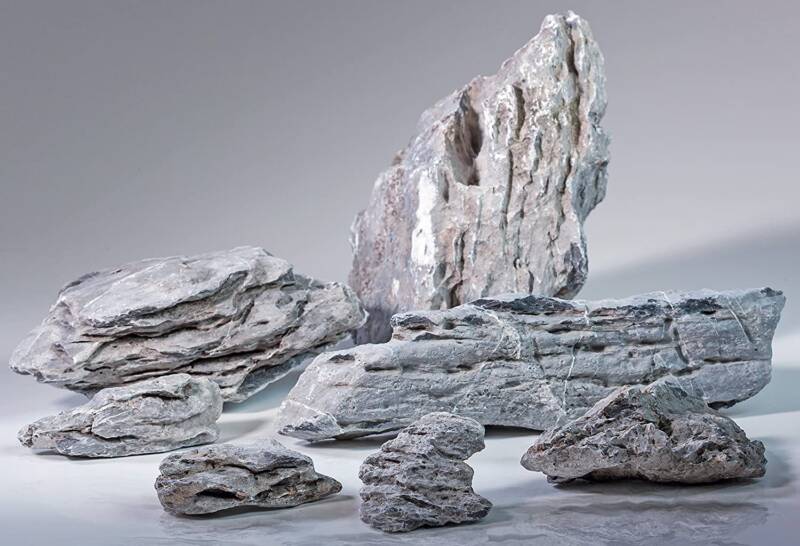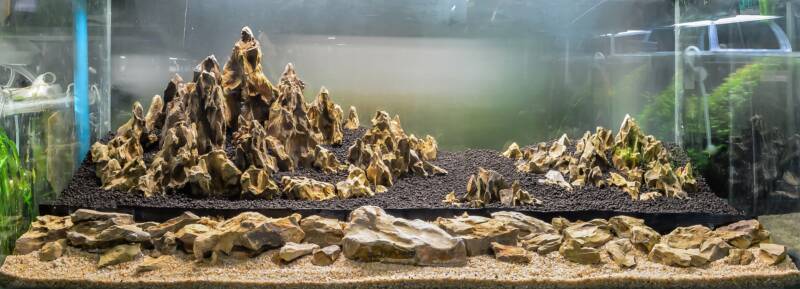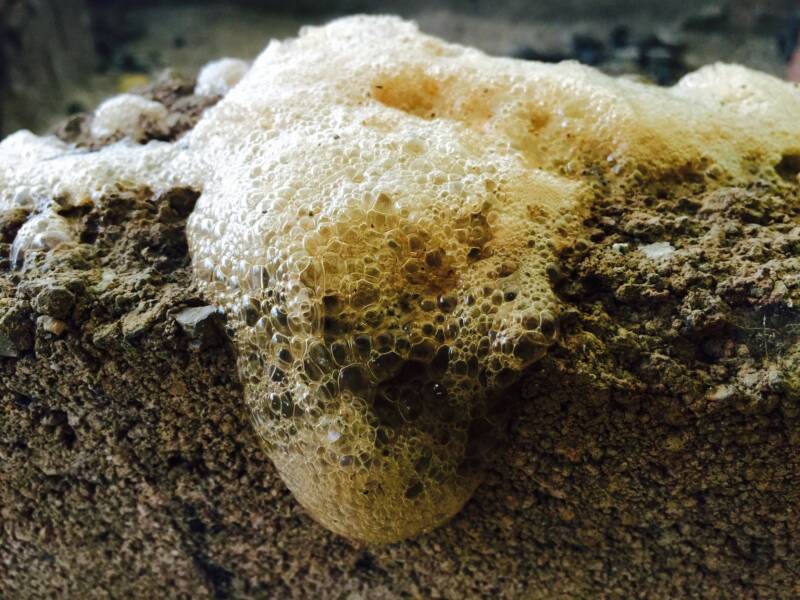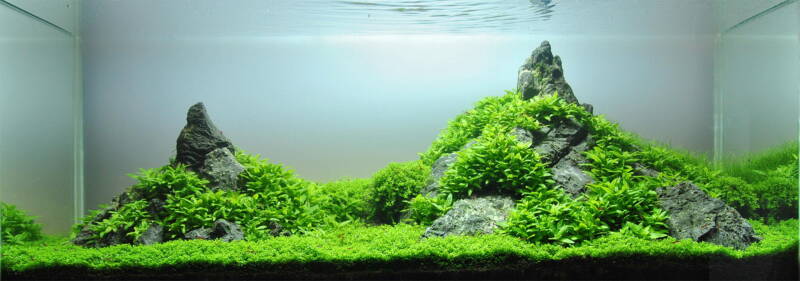Seiryu stone is a type of miniature aquarium rock that is popular in aquascaping tropical aquariums.
With their beautiful marbling effects and blueish hue, they can add a striking impact.

Seiryu stones are naturally occurring, but have many features that make them particularly desirable. In this post, we will examine why seiryu stone is such a great choice for your aquarium, and how to use them to maximum effect without hurting your fish.
[toc]
What is Seiryu Stone?
Seiryu stone ranges in color from deep-blue to a blackish-grey. This color depends a little on whether the stone has been acid-treated and it shouldn’t be confused with the grey-slate appearance of similar stones.
The metamorphic rock has a very layered appearance with attractive jagged edges that gives it a lot of visual intrigues. That detail is caused by calcite veins.
True seiryu stone originates from Japan and is also referred to as dragon stone.
In fact, the name “seiryu stone” refers to the “Azure Dragon,” this is a mythical constellation with blue scales that of course inspired the naming of the blue rock.
The seiryu stone became popular in aquascaping when it was introduced to the world by Takashi Amano, who created the Amano (nature) and Iwagumi styles of aquascaping (more on this in a moment).
Making Sure You Get the Genuine Article!
Keep in mind that many seiryu stones purchased outside of Japan are actually ryouh stones – stones that look similar and are commonly confused.
Ryouh stones are a great addition to an aquarium in their own right, but they are somewhat distinct from seiryu and slightly less sought after. You can tell the difference because ryouh has a tendency to appear more slate grey and with slightly less detail.
For many, this is less desirable as it is the blueish tone that makes true seiryu particularly beautiful! This also allows the white veins to really stand out in contrast.
Check out this selection of great stones.
How to Use Seiryu Stone

If you want to use seiryu stone in your aquarium, you need to be aware of a few things.
These stones may slightly raise the pH and the gH.
However, this change to water parameters is generally very minimal and should not be enough to be a source of concern – depending on the features and aquascape rocks that you also include in your aquarium.
Of course, when considering whether to invest in seiryu stones for your tank, you need to consider the size of the tank, the amount of stone you are going to use, the type of fish/shrimp that are in the water, and the other stone features that you intend on using.
How to Balance Chemistry With Seiryu
As metamorphic rocks, seiryu is typically going to have some effect on water chemistry (unlike sedimentary rocks which are usually inert).
gH refers to the calcium/magnesium concentration, whereas kH refers to carbonate concentration. Together, these minerals alter pH – acidity/alkalinity.
Before you insert your new stone, it is a good idea to test for its acidity or alkalinity.
You can perform the carbonate test on the stone itself by adding a little HCL chloride hydrochloride and then waiting for it to react.
If it sizzles slightly, this shows you that it is alkaline.

Another option is to use vinegar or muriatic acid.
These will likewise cause fizzling if the rock is indeed alkaline. Make sure to include drops on the veins and any marbling, as these areas may feature a different chemical composition.
It is common for this stone to be a little alkaline and to alter the pH of the water in this direction. This may upset certain fish such as Liverbearers and Rift Lake Cichlids if you use large amounts of the stone.
For that reason, it is important to make frequent water changes. You can also try including some acidity buffers – a good example is to use driftwood that is slightly acidic and can, therefore, counteract the alkaline nature of this stone.
Other options include:
- Indian Almond Leaves
- Alder Cones
- Peat Moss/ADA Aquasoil
Aquasoil and peat moss are high in humic acid and this makes them effective at increasing the acidity.
Likewise, injecting carbon dioxide directly into aquascapes can also help to manage levels (this is recommended to manage lush live plant growth).
Acid Treating
If you find that your water parameters are leaning too far toward alkaline, then another option is to treat your stones with some acid. This is a technique that can be used on many rocks, and that will help to alter the chemical balance.
Muriatic acid is available from many home maintenance stores and can help to alter the chemical composition of rocks that have been immersed for 5-10 minutes.
Keep in mind however that this process will also alter the color of the stones. In the case of seiryu, this is likely to result in a slightly blacker-shade with white marbling.
It is still quite different from the slate-grey of rhyou, and many people actually prefer this look and find it very attractive!
This is a simple process, but you need to make sure to protect yourself. Wear protective headgear and glasses, and keep it away from bare skin. Likewise, try not to inhale the fumes if at all possible!
This is a trick you can also use with other rocks. It’s possible to purchase rocks that have been pre-treated with acid. This saves you the job!
Design and Layout

Likewise, it’s also important to think about how the different stones you are using in conjunction will impact on the overall look of your aquascaping.
For those fairly new to the topic, consider that there are many different “styles” of aquascaping that you can employ.
Seiryu stone works best with what is known as the Iwagumi layout. This is a decor approach that combines lots of different carpet plants and stones for a natural aesthetic. Those blueish hues can look especially striking against the vivid greens of plants and any colorful fish.
“Showpiece” seiryu stone can be used to create a kind of mountain effect. Here, you might use a few stones jutting out of the scenery, surrounded by larger plants.
This can have a dramatic impact and really add to your aquascaping.
Other rocks that look similar and that work well together with seiryu include pagoda rock, ohko stone, granite, and of course ryouh.
Sticking with similar-looking rocks will create a more varied environment while also keeping a natural appearance.
How to Break Seiryu Stone
When you order your rocks, you may find that you get more seiryu stone than you need, or that you don’t like the way it looks.
Fortunately, this stone can be broken down to better suit your intended purposes – though it is a little trickier to do this than with some other rocks. The key is to ensure that the break looks natural.
If you simply try to cut the stone, it will appear very flat and man-made and that can hurt the organic effect that the best stones lend the decor. We recommend using a hammer and a chisel to carefully chip away at the rocks while maintaining a jagged effect.
Again, you should wear safety goggles to avoid shards that might otherwise get in your eyes.
If you do decide to make a clean cut, then you can always surround this area with taller plants, or have it facing away from the viewer.
Is Seiryu Stone Shrimp Safe?
One of the biggest questions people will have when buying these stones is whether they are safe to use with shrimps. The good news is that this stone is great for shrimps due to the low impact on pH and gH.
Any of the following shrimp will be perfectly fine in your tank:
- Red cherry shrimp
- Ghost shrimp / Glass shrimp
- Amano shrimp
Of course, you should always check acidity regularly and especially before introducing new rocks, however.
If you keep crystal red shrimp, then you may need to be more careful. This is where acid treating and careful balancing practices become more important.
Closing Thoughts
If you’re looking for a stunning stone with an attractive blue hue and amazing deep cuts, seiryu stone is one of the best choices.
This is a great addition to any hardscape, that has minimal impact on your water parameters and pH, and is great for shrimps.
When buying these stones, you should be careful to get genuine seiryu rock and not the slightly less desirable ryouh stone (although these can be attractive as well).
Think about the other stone that you’re going to be using in the tank, and create a design that is natural but eye-catching!
